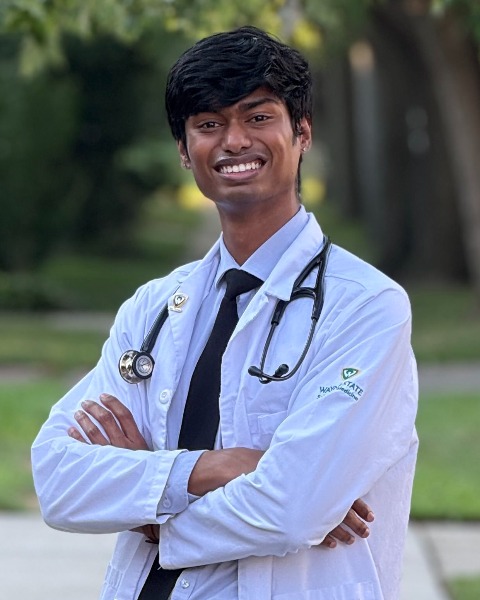Tuesday Poster Session
Category: Liver
P6140 - Management and Outcomes Following Coronary Artery Bypass Graft and Liver Transplant
Tuesday, October 28, 2025
10:30 AM - 4:00 PM PDT
Location: Exhibit Hall

Hariharan Ramakrishnan, BS (he/him/his)
Wayne State University School of Medicine
Shelby Township, MI
Presenting Author(s)
Hariharan Ramakrishnan, BS1, Syed-Mohammed Jafri, MD2
1Wayne State University School of Medicine, Shelby Township, MI; 2Henry Ford Health, Detroit, MI
Introduction: Coronary artery disease (CAD) in patients with cirrhosis presents unique therapeutic challenges. Combined coronary artery bypass grafting (CABG) and liver transplantation (LT) is rare but feasible in carefully selected cases. Here we describe two patients undergoing simultaneous CABG and LT.
Case Description/
Methods: A 71-year-old male with CAD and metabolic-associated steatohepatitis cirrhosis complicated by chronic portal vein thrombosis and hepatocellular carcinoma undergoes simultaneous three-vessel CABG and donation after circulatory death liver transplant following successful downstaging of his hepatocellular carcinoma to within Milan criteria. Intraoperative transesophageal echocardiography post-CABG demonstrates preserved biventricular function, left ventricular ejection fraction of 55%, normal valvular structure, and no significant pericardial effusion. Postoperative complications include atrial fibrillation managed with amiodarone weaned off at 3 months, severe diarrhea necessitating immunosuppressant adjustments, hyperkalemia with acute kidney injury, and prolonged debility requiring inpatient rehabilitation. He is discharged to inpatient rehabilitation one month post-transplant and returns home approximately seven weeks post-transplant, continuing to experience mild persistent symptoms such as dysgeusia and reduced appetite.
A 51-year-old male with CAD and primary sclerosing cholangitis undergoes simultaneous three-vessel CABG and orthotopic liver transplant. Intraoperative transesophageal echocardiography post-CABG demonstrates left ventricular ejection fraction of 65% with no regional wall motion abnormalities, normal ventricular size, and mild hypertrophy, trace mitral and tricuspid regurgitation, and no significant aortic insufficiency or effusion. His postoperative course includes atrial fibrillation with rapid ventricular response, which resolves, and an anastomotic biliary stricture managed by endoscopic retrograde cholangiopancreatography. Post-transplant, he demonstrates excellent liver function. He later experiences weight gain and suboptimal glycemic control, initiating therapy with a glucagon-like peptide-1 receptor agonist.
Discussion: Combined CABG and LT requires careful patient selection and multidisciplinary coordination. Early postoperative complications commonly include cardiac arrhythmias and transplant-specific issues. Long-term outcomes depend on comprehensive management of cardiovascular, metabolic, and transplant-related risks.
Disclosures:
Hariharan Ramakrishnan indicated no relevant financial relationships.
Syed-Mohammed Jafri: Abbvie – Speakers Bureau. Gilead – Speakers Bureau. Intercept – Speakers Bureau. Ironwood – Speakers Bureau. Takeda – Speakers Bureau.
Hariharan Ramakrishnan, BS1, Syed-Mohammed Jafri, MD2. P6140 - Management and Outcomes Following Coronary Artery Bypass Graft and Liver Transplant, ACG 2025 Annual Scientific Meeting Abstracts. Phoenix, AZ: American College of Gastroenterology.
1Wayne State University School of Medicine, Shelby Township, MI; 2Henry Ford Health, Detroit, MI
Introduction: Coronary artery disease (CAD) in patients with cirrhosis presents unique therapeutic challenges. Combined coronary artery bypass grafting (CABG) and liver transplantation (LT) is rare but feasible in carefully selected cases. Here we describe two patients undergoing simultaneous CABG and LT.
Case Description/
Methods: A 71-year-old male with CAD and metabolic-associated steatohepatitis cirrhosis complicated by chronic portal vein thrombosis and hepatocellular carcinoma undergoes simultaneous three-vessel CABG and donation after circulatory death liver transplant following successful downstaging of his hepatocellular carcinoma to within Milan criteria. Intraoperative transesophageal echocardiography post-CABG demonstrates preserved biventricular function, left ventricular ejection fraction of 55%, normal valvular structure, and no significant pericardial effusion. Postoperative complications include atrial fibrillation managed with amiodarone weaned off at 3 months, severe diarrhea necessitating immunosuppressant adjustments, hyperkalemia with acute kidney injury, and prolonged debility requiring inpatient rehabilitation. He is discharged to inpatient rehabilitation one month post-transplant and returns home approximately seven weeks post-transplant, continuing to experience mild persistent symptoms such as dysgeusia and reduced appetite.
A 51-year-old male with CAD and primary sclerosing cholangitis undergoes simultaneous three-vessel CABG and orthotopic liver transplant. Intraoperative transesophageal echocardiography post-CABG demonstrates left ventricular ejection fraction of 65% with no regional wall motion abnormalities, normal ventricular size, and mild hypertrophy, trace mitral and tricuspid regurgitation, and no significant aortic insufficiency or effusion. His postoperative course includes atrial fibrillation with rapid ventricular response, which resolves, and an anastomotic biliary stricture managed by endoscopic retrograde cholangiopancreatography. Post-transplant, he demonstrates excellent liver function. He later experiences weight gain and suboptimal glycemic control, initiating therapy with a glucagon-like peptide-1 receptor agonist.
Discussion: Combined CABG and LT requires careful patient selection and multidisciplinary coordination. Early postoperative complications commonly include cardiac arrhythmias and transplant-specific issues. Long-term outcomes depend on comprehensive management of cardiovascular, metabolic, and transplant-related risks.
Disclosures:
Hariharan Ramakrishnan indicated no relevant financial relationships.
Syed-Mohammed Jafri: Abbvie – Speakers Bureau. Gilead – Speakers Bureau. Intercept – Speakers Bureau. Ironwood – Speakers Bureau. Takeda – Speakers Bureau.
Hariharan Ramakrishnan, BS1, Syed-Mohammed Jafri, MD2. P6140 - Management and Outcomes Following Coronary Artery Bypass Graft and Liver Transplant, ACG 2025 Annual Scientific Meeting Abstracts. Phoenix, AZ: American College of Gastroenterology.
